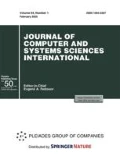Abstract
An analytical approach is developed to integrate redundant equipment complexes (ECs) with linear stationary models. A general technique for managing the redundancy of the complex at the design stage is formulated in the case of ensuring the invariance of the given set of transfer functions. A formalism is obtained for solving the integration problem of a complex when it is configured as a sequence of related subsystems. The formalism includes both the conditions for the admissibility of a preselected configuration and the formula for the entire set of alternative relationships between components that ensure the fulfillment of the given objective function of the complex. An example of a simple navigation system consisting of measuring and indicator subsystems is given.



Similar content being viewed by others
REFERENCES
B. S. Aleshin, V. I. Babkin, L. M. Gokhberg, et al., Foresight of the Development of Aviation Science and Technology until 2030 and Beyond (TsAGI, Moscow, 2014) [in Russian].
V. N. Bukov, A. V. Evgenov, and V. A. Shurman, “Integrated systems of avionics with controlled functional redundancy,” in Proceedings of the Academic Zhukovskii Readings, 5th International Conference (VUNTs VVS VVA, Voronezh, 2017), pp. 32–40.
V. N. Bukov, A. V. Evgenov, and V. A. Shurman, “Functional redundancy management of advanced integrated avionics systems,” in Proceedings of the Workshop of Interdepartmental Working Group to Prepare Proposals Aimed at Identifying Promising and Breakthrough Areas of Scientific, Technical and Innovative Development of the Aviation Industry (Moscow, Studiya Etnika, 2018), pp. 45–53.
A. A. Tarasov, Functional Reconfiguration of Fault Tolerant Systems (Logos, Moscow, 2012) [in Russian].
A. M. Ageev, A. M. Bronnikov, V. N. Bukov, and I. F. Gamayunov, “Supervisory control method for redundant technical systems,” J. Comput. Syst. Sci. Int. 56, 410 (2017).
V. N. Bukov, A. M. Bronnikov, A. M. Ageev, and I. F. Gamayunov, “An analytic approach to constructing configurations of technical systems,” Autom. Remote Control 78, 1600 (2017).
I. F. Gamayunov, “Generation of alternative solutions in the redundancy management problem for hardware complexes,” Autom. Remote Control 79, 655 (2018).
A. M. Ageev, “Configuring of excessive onboard equipment sets,” J. Comput. Syst. Sci. Int. 57, 640 (2018).
V. N. Bukov and A. M. Bronnikov, “Testing the configurations of redundant integrated equipment complexes,” Autom. Remote Control 80, 262 (2019).
V. N. Bukov, A. M. Bronnikov, A. M. Ageev, and I. F. Gamayunov, “Integration of an equipment complex with a selected configuration,” Autom. Remote Control 80, 676 (2019).
B. T. Polyak and P. S. Shcherbakov, Robust Stability and Control (Nauka, Moscow, 2002) [in Russian].
Methods of the Classical and Modern Theory of Automatic Control, The School-Book, Vol. 1: Mathematical Models, Dynamic Characteristics and Analysis of Automatic Control Systems, Ed. by K. A. Pupkov and N. D. Egupov (Izd. MGTU im. N. E. Baumana, Moscow, 2004) [in Russian].
V. N. Bukov, Embedding Systems. An Analytical Approach to the Analysis and Synthesis of Matrix Systems (Izdat. Nauch. Liter. N. F. Bochkarevoi, Kaluga, 2006)) [in Russian].
S. V. Goryunov and V. N. Bukov, “Inversion and canonization of block matrices,” Math. Notes 79, 614 (2006).
A. Aho, J. E. Hopcroft, and J. D. Ullman, The Design and Analysis of Computer Algorithms (Addison-Wesley, Reading, MA, 1974).
Author information
Authors and Affiliations
Corresponding author
APPENDIX
APPENDIX
Proof of the theorem. The solution to the problem is related to the resolution of the equation
where the left side is determined by formula (3.5) with the nominal values of the corresponding matrices relative to the matrix \(E{{}^{{21}}}(z)\). We use the lemma on the inverse of block matrices [15], according to which the following equality is justified:
As a result, by introducing the notation \({{\Phi }_{{{\text{req}}}}}(z) = [\begin{array}{*{20}{c}} 0&{\beta ''W_{{y{\text{nom}}}}^{{v}}(z)\alpha } \end{array}]\), we get the equation
which after fulfilling the matrix products takes the form
where, taking into account the notation introduced in (1.11), the following value is used:
Taking into account notation (4.1) and (4.2), we obtain the equation
which after substitution (A.2) takes the form of a two-sided linear equation with respect to the matrix E21(z):
The solvability conditions for this equation appear in [13] as equalities (4.3) and (4.4), and the solution is determined by formulas (4.5) and (4.6). The theorem is proved.
Rights and permissions
About this article
Cite this article
Ageev, A.M., Bronnikov, A.M., Bukov, V.N. et al. Generation of Alternative Connections of Series-Connected Subsystems in a Redundant Equipment Complex. J. Comput. Syst. Sci. Int. 59, 232–244 (2020). https://doi.org/10.1134/S1064230720020021
Received:
Revised:
Accepted:
Published:
Issue Date:
DOI: https://doi.org/10.1134/S1064230720020021


